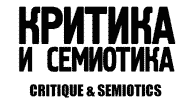Search
| # | Search | Downloads | ||||
|---|---|---|---|---|---|---|
| 1 | The work of a contemporary artist with fonts cannot be interpreted only on the basis of the traditions the artist refers. It is necessary to study actors who actualize traditions. The font, being a design element, in art can acquire the meaning of a bodily code that determines bodily reactions to social memory. The article examines the projects of one of the world’s leading media artists working with fonts. It is demonstrated that the semiotics of the textual sign can be supplemented by the premises and conclusions of Bruno Latour’s actor–network theory. The actor–network theory insists on the instability of systems and on the compensatory function of the body: the body is not some basis of experience or observation, but one of the factors of the presence of action, which makes it necessary to keep the system in a mobile equilibrium. The body participates in, rather than cognizes, a system of relations between cognizing and cognizable things networked together. Oded Ezer’s case study examines the implantation of the script in cultural memory, made possible by the development of media in art. Oded Ezer, although drawing on the traditions of the Jewish mysticism of the letter and the achievements of contemporary media art, understands the letter as a multiple authorized element embedded in networks of perception, both everyday and specialized. The plasticity of the works brings everyday optics closer to the optics of specialized practices, primarily medical, which engage different things as equals inside networked interactions to ensure a sustainable equilibrium of production. In this way, the actor–network theory proves productive for interpreting art that is neither reducible to science art nor to a reflection on the past. Ezer’s work needs to be reconstructed rather than interpreted, drawing on the advances of the actor–network theory and the critical study of self-presentation. The body proves to be the most malleable actor in the network, allowing us to identify gaze and memory, touch and action. Ezer’s work is not merely performative; it brings together different forms of participation, and thus its effect can be labeled as a typographic metaperformativity that incorporates natural objects as well. Ezer’s self-disclosure of the method is carried out in his work on the legacy of Franz Kafka, abandoning interpretation in favor of endowing Kafka’s metamorphoses with a new sense of biohacking in which human and non-human agents participate. Kafka’s hero turns out to be not just the author of fate, but the author of books and the creator of the mode of book production; i.e., the method associated with the actor–network theory is reproduced in the semiotic expressiveness of this work. Keywords: bioart, font design, actor–network theory, Oded Ezer, Franz Kafka, science art, media, communication, performativity, corporeality | 243 | ||||










